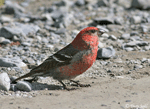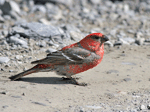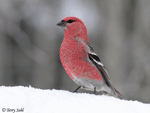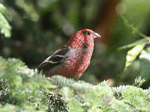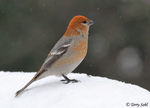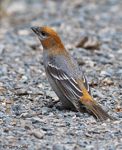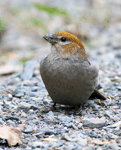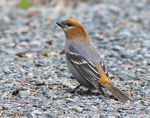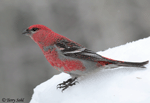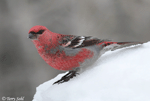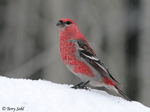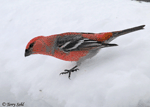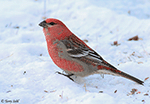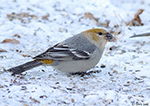| Length: 9.5 inches | Wingspan: 14 inches | Seasonality: Rare in Winter |
| ID Keys: Pink and gray (male), females gray with yellow on head, long tail, stubby bill, two white wing-bars | ||
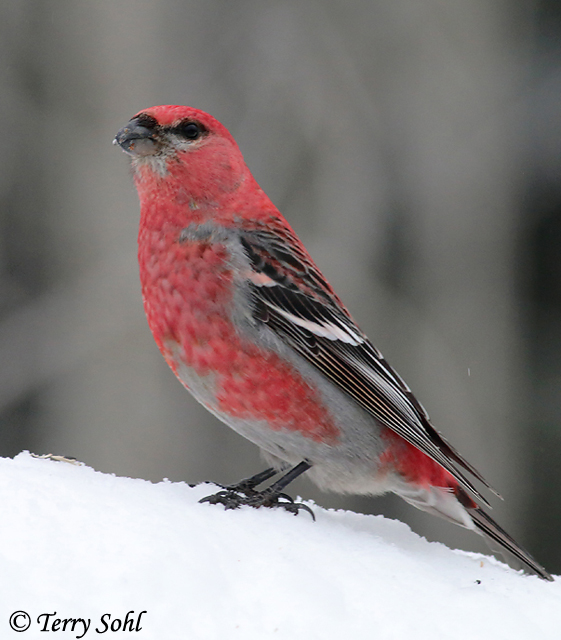 The
Pine Grosbeak is normally a bird of the boreal forests of Canada and the
mountain west of the United States. However, when food conditions are
poor in their normal range, they may stage large irruptive migrations well
to the south and east, including to parts of South Dakota. They have been
found in scattered locations from all parts of the state, but never in very high
numbers, and generally not consistently to the same locations. Closest
breeding locations are in far northern Minnesota.
The
Pine Grosbeak is normally a bird of the boreal forests of Canada and the
mountain west of the United States. However, when food conditions are
poor in their normal range, they may stage large irruptive migrations well
to the south and east, including to parts of South Dakota. They have been
found in scattered locations from all parts of the state, but never in very high
numbers, and generally not consistently to the same locations. Closest
breeding locations are in far northern Minnesota.
Habitat:
Found in open conifer forest during the summer breeding season. Usually, it's spruce and fir they're found in, not pine (despite the name). In winter, they can also often be found in deciduous trees, especially trees that produce edible fruit.
Diet:
Primarily feeds on plant material, especially the seeds of conifers and other trees, tree buds, fruits and berries, and occasionally the seeds of weeds and grasses. They will also eat insects when available during the summer months.
Behavior:
Moves deliberately branches of trees and shrubs when foraging, often in small flocks.
Breeding:
Non-breeder in South Dakota. In their breeding range, the nest of a Pine Grosbeak is typically placed in a dense evergreen tree, between 4 and 15 feet from the ground, occasionally somewhat higher. The nest is built on a foundation of twigs, weed stems, and roots, with an inner cup lined with fine grasses, lichen, moss, or hair. The female builds the nest, and lays between 2 and 5 eggs. Young hatch after about 2 weeks, and fledge from the nest after another 2 to 3 weeks.
Song:
Rich, whistled warbling from the male. They also have multi-note flight calls that are variable based on location
- Click here to hear the song of a male Pine Grosbeak, recorded in Finland.1
- Click here to hear the three-note call of a Pine Grosbeak, recorded on the Kenai Peninsula in Alaska2
- Click here to hear the twittering calls of a Pine Grosbeak from northern Norway, demonstrating the variable call notes between locations.3
Migration:
Primarily a permanent resident throughout much of its range, although birds at the northern end of its range may move southward in the winter. They do sometimes make winter 'invasions' well to the south of their normal range if poor food conditions exist.
Interactive eBird Map:
Click here to access an interactive eBird map of Pine Grosbeak sightings
Bird Feeders:
Will attend feeders for various seeds, especially sunflower seeds.
South Dakota "Hotspot"
As rare winter visitors, there is no consistent "hotspot", but the area with the most sightings has been around Aberdeen, with sightings for multiple years at both the Mina Lake Recreation Area, and Richmond Lake State Park. Sightings have also been made in multiple years in the Pierre area, including personal sightings by myself on 2 occasions along the shores of Lake Oahe, just northwest of the dam. Overall though, Pine Grosbeaks aren't generally a species you can go out and specifically hope to find in South Dakota, unless there are specific reports that you can follow up on.
Similar Species:
Coloring and bill shape are distinctive compared to some other somewhat similar species. Species most likely to be confused with a Pine Grosbeak include:
- Red Crossbill - Color of an adult Red Crossbill is different, as they are more orangish-red while Pine Grosbeaks are a rosy red. The namesake bill of a Red Crossbill is crossed and longer compared to the shorter, more stout bill of a Pine Grosbeak. Red Crossbills lack the white wing bars found on Pine Grosbeaks. Male Red Crossbills are more uniformly red, while (male) Pine Grosbeaks have various amounts of gray on their belly and under their wing. Similarly, female Red Crossbills are more uniformly yellow while female Pine Grosbeaks have gray on their belly and near their wings.
- White-winged Crossbill - With white wing bars and coloring similar to a Pine Grosbeak, including some gray on the male that can look like the gray belly of a Pine Grosbeak, White-winged Crossbills are the species perhaps most easily confused with Pine Grosbeak. However, White-winged Crossbills are smaller, and have the namesake crossed bill. The wings of a White-winged Crossbill are also darker than a Pine Grosbeak.
- House Finch - House Finch males may have a similar rosy-red coloring, but they are considerably smaller than a Pine Grosbeak, and have extensive streaking on their belly, sides, and back that is lacking from a Pine Grosbeak. Female House Finches lack the yellowish coloring of a female Pine Grosbeak. The bill of a Pine Grosbeak is stouter than a House Finch.
- Purple Finch - See comments above for House Finch. Purple finches are smaller and streakier than Pine Grosbeaks.
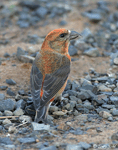 |
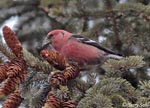 |
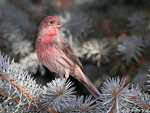 |
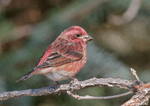 |
| Red Crossbill | White-winged Crossbill | House Finch | Purple Finch |
Conservation Status:
Numbers appear to be decreasing in the North American portion of their range, with Breeding Bird Survey and Christmas Bird Count numbers both declining over the last 40 years. The species is also found in parts of Eurasia, where population trends are less well known. Overall though they are found over a very broad geographic area and are common in parts of their range. The IUCN lists the Pine Grosbeak as a species of "least concern".
Further Information:
- USGS Patuxent Bird Identification InfoCenter: Pine Grosbeak
- WhatBird - Pine Grosbeak
- Audubon Guide - Pine Grosbeak
Photo Information:
January 15th, 2019 - Sax-Zim Bog in northern Minnesota - Terry Sohl
Additional Photos:
Click on the image chips or text links below for additional, higher-resolution Pine Grosbeak photos.
Audio File Credits:
- 1Terje Kolaas, XC424091. Accessible at www.xeno-canto.org/424091
- 2Patrik Aberg, XC406267. Accessible at www.xeno-canto.org/406267
- 3Stein Nilsen, XC397528. Accessible at www.xeno-canto.org/397528
| Click on the range map below for a higher-resolution view |
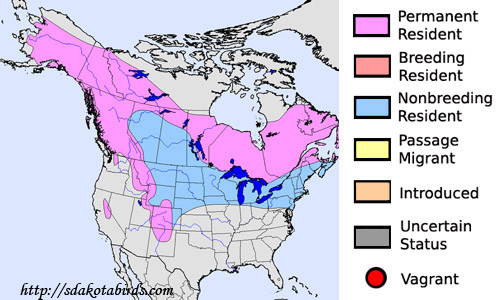 |
| South Dakota Status: Irregular, rare visitor in winter, with sightings in locations from around the state. |
Additional Pine Grosbeak Photos
Click for a higher-resolution version of these photos
